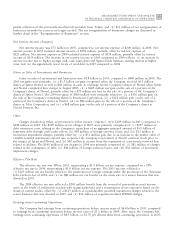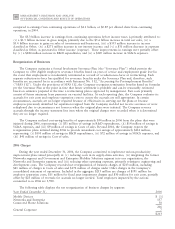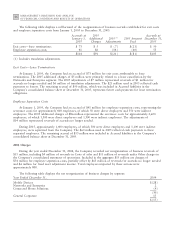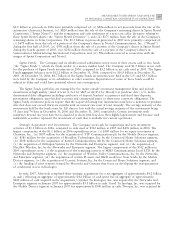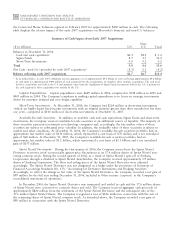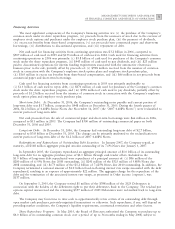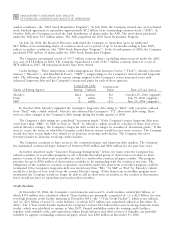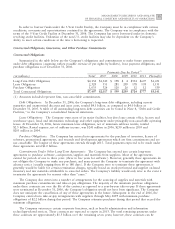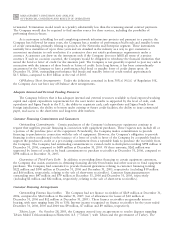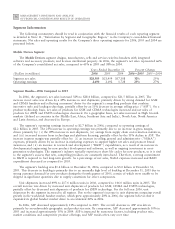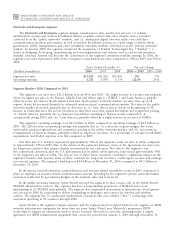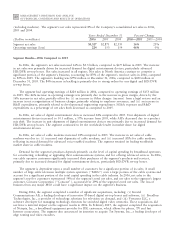Motorola 2006 Annual Report Download - page 60
Download and view the complete annual report
Please find page 60 of the 2006 Motorola annual report below. You can navigate through the pages in the report by either clicking on the pages listed below, or by using the keyword search tool below to find specific information within the annual report.
52 MANAGEMENT'S DISCUSSION AND ANALYSIS
OF FINANCIAL CONDITION AND RESULTS OF OPERATIONS
market conditions (the ""2005 Stock Repurchase Program''). In July 2006, the Company entered into an accelerated
stock buyback agreement to repurchase approximately $1.2 billion of its outstanding common stock (""ASB''). In
October 2006, the Company received the final distribution of shares under the ASB. The total shares purchased
under the ASB were 50.5 million shares. The ASB completed the 2005 Stock Repurchase Program.
On July 24, 2006, the Board of Directors authorized the Company to repurchase up to an additional
$4.5 billion of its outstanding shares of common stock over a period of up to 36 months ending in June 2009,
subject to market conditions (the ""2006 Stock Repurchase Program''). In the fourth quarter of 2006, the Company
purchased $700 million of shares under the 2006 Stock Repurchase Program.
The Company repurchased a total of 171.7 million common shares (including shares received under the ASB)
at a cost of $3.8 billion in 2006. The Company repurchased a total of 41.7 million common shares at a cost of
$874 million in 2005. All repurchased shares have been retired.
Credit Ratings: Three independent credit rating agencies, Fitch Investors Service (""Fitch''), Moody's Investor
Services (""Moody's''), and Standard & Poor's (""S&P''), assign ratings to the Company's short-term and long-term
debt. The following chart reflects the current ratings assigned to the Company's senior unsecured non-credit
enhanced long-term debt and the Company's commercial paper by each of these agencies.
Long-Term Debt Commercial
Name of Rating Agency Rating Outlook Paper Date of Last Action
Moody's Baa1 positive P-2 October 25, 2006 (upgrade)
Fitch A- stable F-1 July 19, 2006 (upgrade)
S&P A- stable A-1 June 26, 2006 (upgrade)
In October 2006, Moody's upgraded the Company's long-term debt rating to ""Baa1'' with a positive outlook
from ""Baa2'' with a stable outlook. Moody's also affirmed the Company's ""P-2'' short-term debt rating. There
were no other changes in the Company's debt ratings during the fourth quarter of 2006.
The Company's debt ratings are considered ""investment grade.'' If the Company's senior long-term debt were
rated lower than ""BBB-'' by S&P or Fitch or ""Baa3'' by Moody's (which would be a decline of three levels from
current Moody's ratings), the Company's long-term debt would no longer be considered ""investment grade.'' If this
were to occur, the terms on which the Company could borrow money would become more onerous. The Company
would also have to pay higher fees related to its domestic revolving credit facility. The Company has never
borrowed under its domestic revolving credit facilities.
The Company continues to have access to the commercial paper and long-term debt markets. The Company
has maintained commercial paper balances of between $300 million and $400 million for the past four years.
As further described under ""Customer Financing Arrangements'' below, for many years the Company has
utilized a number of receivables programs to sell a broadly-diversified group of short-term receivables to third
parties. Certain of the short-term receivables are sold to a multi-seller commercial paper conduit. This program
provides for up to $500 million of short-term receivables to be outstanding with the conduit at any time. The
obligations of the conduit to continue to purchase receivables under this short-term receivables program could be
terminated if the Company's long-term debt was rated lower than ""BB°'' by S&P or ""Ba1'' by Moody's (which
would be a decline of four levels from the current Moody's rating). If this short-term receivables program were
terminated, the Company would no longer be able to sell its short-term receivables to the conduit in this manner,
but it would not have to repurchase previously-sold receivables.
Credit Facilities
At December 31, 2006, the Company's total domestic and non-U.S. credit facilities totaled $4.0 billion, of
which $175 million was considered utilized. These facilities are principally comprised of: (i) a $2.0 billion five-year
revolving domestic credit facility maturing in December 2011 (the ""5-Year Credit Facility'') which is not utilized,
and (ii) $2.0 billion of non-U.S. credit facilities (of which $175 million was considered utilized at December 31,
2006). The 5-Year Credit Facility replaced the Company's former $1.0 billion three-year revolving domestic credit
facility, which was scheduled to mature in May 2007. Unused availability under the existing credit facilities,
together with available cash, cash equivalents, Sigma Funds balances and other sources of liquidity, are generally
available to support outstanding commercial paper, which was $300 million at December 31, 2006.



